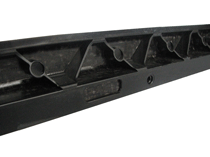The lower beam of the front end of the new Audi A8 is the high-end proving ground for a new organic plastic sheet developed by plastics and chemicals supplier Lanxess. Hybrid plastic/metal composites have become firmly established in the automotive industry for the manufacture of lightweight, high-strength structural parts such as front ends, pedal support brackets and brake pedals.
March 29, 2010
The lower beam of the front end of the new Audi A8 is the high-end proving ground for a new organic plastic sheet developed by plastics and chemicals supplier Lanxess. Hybrid plastic/metal composites have become firmly established in the automotive industry for the manufacture of lightweight, high-strength structural parts such as front ends, pedal support brackets and brake pedals.
|
All-polyamide hybrid structures would be easier to recycle, lighter in weight, and allow for greater design freedom. |
This new structure, though, is trying to keep all of the benefits of established plastic/metal ones, such as lightweight combined with high strength and stiffness, while doing away with the metal.
Key to the new structures is what Lanxess describes as 'organic plastic sheet' that is used for local reinforcement instead of aluminum or steel in molded parts. For the lower beam of the front end of the new Audi A8, a U-shaped profile made of the lightweight material is used. "This front end proves that organic sheet meets all the requirements relating for instance to torsional and flexural strength. It is an excellent alternative to steel and aluminum sheet in hybrid technology," said Ulrich Dajek, a design expert at the supplier.
This Audi front end is just the start, predicted Dajek: "We regard the component as an intermediate step to all-plastic hybrid front ends...using only inserts of organic sheet in combination with polyamide 6."
Lanxess of course hopes its Durethan-brand PA6 gets the call for these parts, as its Easy-flow Durethan BKV 30 EF (30% glass fiber reinforcement) did in the Audi front end. Bond-Laminates GmbH (Brilon, Germany) supplies the organic sheet, which it markets under its Tepex brand. This sheet is formed from thermoplastics (in this case with polyamide 6 as the matrix) reinforced with continuous fibers.
To manufacture a hybrid component, the organic sheet is first heated, formed and trimmed. The part is then placed in an injection molding tool and strengthened with ribbing or reinforcements made, for example, of PA6, thus forming a material bond. Lanxess is working with partner firms to move the separate forming step into the injection mold, so that forming and injection can be carried out in a single operation.
|
The "organic sheet" reinforcement is just 1 mm thick. |
The organic sheet reinforcement for the Audi A8 lower beam - aluminum sheet is used for the upper beam - is just 1.0 mm thick. "We estimate that the use of organic sheet instead of aluminum sheet can, in general, open up further weight-saving potential of around 10% (per part)," said Dajek.
Another new form of hybrid technology being developed at Lanxess with partners in the industry is based on sheet steel coated with adhesion promoters. The steel is first formed and then inserted into an injection mold, where overmolding gives it a polyamide rib structure. This results in a full-surface hybrid bond between the metal and the plastic as opposed to a number of separate anchoring points.
"The quasi-static simulation of 3-point bending on the Erlangen beam showed that a bond of this sort can withstand forces twice as high as a bond produced by standard hybrid technology, and is also much more flexurally and torsionally stiff," explained Ralf Zimnol, head of applications development in Lanxess's semi-crystalline materials business unit.
About the Author(s)
You May Also Like




